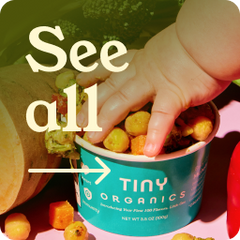New USDA Guidelines for Babies & Toddlers

The USDA has released their dietary guidelines with one notable difference: they’ve included babies & toddlers for the first time in 35 years. With the recent news about trace amounts of heavy metals being found in store bought baby food, we know as parents that it's more important than ever to make informed decisions about our little one's nutrition from the earliest days.
“The time from birth until a child’s second birthday is a critically important period for proper growth and development”, the USDA notes in their most recent release of their dietary guidelines.
Previous to this year, these guidelines started around 2 years of age but had not yet expanded to include our littlest ones as well. So what are the most important pieces to note? We broke it down for you.
Here’s how to make every bite count:
- For the first 6 months, breastmilk or iron-fortified infant formula is best. If you’re breastfeeding your babe, consider a Vitamin D supplement soon after birth. The USDA recommends 400 IU per day, but as always, consult with your trusted healthcare provider for what works best for you and your family.
- Around 6 months of age, you can start introducing complementary foods to your little one. If they’re showing signs of readiness, such as sitting up independently, bringing their hands to their mouth, and showing interest in food, then it’s time to get started! You can find our Neonatal Nutritionist’s recommended foods to introduce first here. This is also a good time to start introducing potential allergens. Again, we recommend working with your doctor to introduce allergens safely.
- Avoid added sugars + sodium, as infants and toddlers have high nutrient requirements relative to their size, there isn’t room for added sugars or sweeteners. Also, as the USDA notes, “Taste preferences are being formed during this time period, and infants and young children may develop preferences for overly sweet foods if introduced to very sweet foods during this timeframe.”
- In the second year of life, your little one’s early food preferences can influence their dietary choices later in life, so it is important to offer a variety of vegetables and fruits, protein and grains, while avoiding anything overly processed, as much as you can. Think nutrient-dense foods over added sugars over sodium.
Bottom Line: When it comes to nutrition, the first two years of life are an important stage for your little one’s growth and development. Do the best you can while considering your time available, budget and cultural food preferences. Focus on vegetables and fruits, while avoiding added sugars and sodium for as long as you can. Trust your instincts and keep going!



















